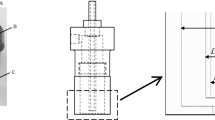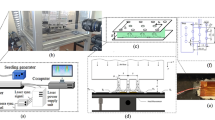Abstract
In this study, the visualization of the flow inside a Taylor cone formed during an electrohydrodynamic (EHD) spraying is conducted to analyze its stability among five liquid candidates. A micro-PIV with a micro-nozzle is used for the visualization, and the physical properties as well as measured values are utilized in the analysis. First, in forming the Taylor cone, the electrohydrodynamic force is required to be sufficiently large in order to overcome the surface tension of the liquid. Thus, among the five liquids tested here, three, in this case IPA, EtOH, and MeOH, form a Taylor cone due to the relatively low surface tension levels as compared to the others. Once electrohydrodynamic jetting occurs, the average and maximum velocities become monotonically proportional to the average current. As the velocities are the smallest in using IPA, the circulation flow becomes superior to the extrusive flow, which yields the stable formation of a Taylor cone. Also, low fluctuation of the instantaneous currents supports the stable formation of IPA. Consequently, IPA shows the most stable formation of the Taylor cone in our condition due to the lowest average current and low-level surface tension. Eventually, micro-PIV would be a good tool in choosing an optimal fluid for stable EHD spraying.
Graphic abstract







Similar content being viewed by others
References
Ahmad Z et al (2008) Freeform fabrication of nano-biomaterials using 3D electrohydrodynamic print-patterning. J Biomed Nanotechnol 4:185–195
Barrero A, Ganan-Calvo A, Davila J, Palacio A, Gomez-Gonzalez E (1998) Low and high Reynolds number flows inside Taylor cones. Phys Rev E 58:7309
Barrero A, Ganan-Calvo A, Davila J, Palacios A, Gomez-Gonzalez E (1999) The role of the electrical conductivity and viscosity on the motions inside Taylor cones. J Electrostat 47:13–26
Choi J, Kim Y-J, Lee S, Son SU, Ko HS, Nguyen VD, Byun D (2008) Drop-on-demand printing of conductive ink by electrostatic field induced inkjet head. Appl Phys Lett 93:193508
Cloupeau M, Prunet-Foch B (1994) Electrohydrodynamic spraying functioning modes: a critical review. J Aerosol Sci 25:1021–1036
Duraisamy N, Muhammad NM, Kim H-C, Jo J-D, Choi K-H (2012) Fabrication of TiO2 thin film memristor device using electrohydrodynamic inkjet printing. Thin Solid Films 520:5070–5074
Fernández de La Mora J (2007) The fluid dynamics of Taylor cones. Annu Rev Fluid Mech 39:217–243
Gim Y, Ko HS (2016) Development of a three-dimensional a three dimensional correction method for optical distortion of flow field inside a liquid droplet. Opt Lett 41(8):1801–1804
Hartman RPA, Brunner D, Camelot D, Marijnissen J, Scarlett B (1999) Electrohydrodynamic atomization in the cone–jet mode physical modeling of the liquid cone and jet. J Aerosol Sci 30:823–849
Herrada M, López-Herrera J, Gañán-Calvo AM, Vega E, Montanero J, Popinet S (2012) Numerical simulation of electrospray in the cone-jet mode. Phys Rev E 86:026305
Jaworek A (2007) Electrospray droplet sources for thin film deposition. J Mater Sci 42:266–297
Kang KH, Lee SJ, Lee CM, Kang IS (2004) Quantitative visualization of flow inside an evaporating droplet using the ray tracing method. Meas Sci Technol 15:1104
Khan A, Rahman K, Hyun M-T, Kim D-S, Choi K-H (2011) Multi-nozzle electrohydrodynamic inkjet printing of silver colloidal solution for the fabrication of electrically functional microstructures. Appl Phys A 104:1113
Lange NA (1944) Handbook of Chemistry vol 58. vol 1. LWW
Meinhart CD, Wereley ST, Santiago JG (1999) PIV measurements of a microchannel flow. Exp Fluids 27:414–419
Nguyen VD, Schrlau MG, Tran SBQ, Bau HH, Ko HS, Byun D (2009) Fabrication of nanoscale nozzle for electrohydrodynamic (EHD) inkjet head and high precision patterning by drop-on-demand operation. J Nanosci Nanotechnol 9:7298–7302
Nguyen TK, Nguyen VD, Seong B, Hoang N, Park J, Byun D (2014) Control and improvement of jet stability by monitoring liquid meniscus in electrospray and electrohydrodynamic jet. J Aerosol Sci 71:29–39
Park S-E, Hwang J-Y, Kim K, Jung B, Kim W, Hwang J (2011) Spray deposition of electrohydrodynamically atomized polymer mixture for active layer fabrication in organic photovoltaics. Sol Energy Mater Sol Cells 95:352–356
Prasad A, Adrian R, Landreth C, Offutt P (1992) Effect of resolution on the speed and accuracy of particle image velocimetry interrogation. Exp Fluids 13:105–116
Saville D (1997) Electrohydrodynamics: the Taylor-Melcher leaky dielectric model. Annu Rev Fluid Mech 29:27–64
Shtern V, Barrero A (1994) Striking features of fluid flows in Taylor cones related to electrosprays. J Aerosol Sci 25:1049–1063
Xu X, Luo J (2007) Marangoni flow in an evaporating water droplet. Appl Phys Lett 91:124102
Acknowledgements
This research was supported by the Basic Science Research Program through the National Research Foundation of Korea (NRF), funded by the Ministry of Science, ICT & Future Planning (NRF-2017R1E1A1A01075353), supported by “Human Resources Program in Energy Technology” of the Korea Institute of Energy Technology Evaluation and Planning (KETEP), granted financial resource from the Ministry of Trade, Industry & Energy(MOTIE) of Korea (No. 20184030202200), and supported by “Supporting the field application and commercialization of underwater construction robots” funded by the Ministry of Oceans and Fisheries, Korea (20190396).
Author information
Authors and Affiliations
Corresponding authors
Additional information
Publisher's Note
Springer Nature remains neutral with regard to jurisdictional claims in published maps and institutional affiliations.
Rights and permissions
About this article
Cite this article
Kim, J., Tran, S.B.Q., Seong, B. et al. Experimental study on fluid selection for a stable Taylor cone formation via micro-PIV measurement. J Vis 23, 449–457 (2020). https://doi.org/10.1007/s12650-020-00631-4
Received:
Revised:
Accepted:
Published:
Issue Date:
DOI: https://doi.org/10.1007/s12650-020-00631-4




